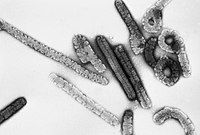
Photo from wikipedia
Crimean-Congo hemorrhagic fever virus (CCHFV) causes mild to severe and fatal disease in humans. Person-to-person transmission is common, necessitating the availability of rapidly deliverable therapeutic and prophylactic interventions to mitigate… Click to show full abstract
Crimean-Congo hemorrhagic fever virus (CCHFV) causes mild to severe and fatal disease in humans. Person-to-person transmission is common, necessitating the availability of rapidly deliverable therapeutic and prophylactic interventions to mitigate CCHFV spread. Previously, we showed complete protection using one dose of a viral replicon particle (VRP) vaccine administered 28 days before CCHFV challenge. In order to determine the utility of the VRP vaccine for rapid vaccination protocols, we assessed the efficacy of such vaccination administered at various intervals relative to challenge in IFNAR-/- mice. Unvaccinated mice uniformly succumbed to disease by 8 days post infection (dpi). All mice vaccinated 14, 7, or 3 days prior to CCHFV challenge survived infection. Mice vaccinated -14 or -7 dpi were fully protected from clinical disease, whereas mice inoculated -3 dpi developed signs of disease prior to recovering to baseline values 5-9 dpi. These data support the utility of the VRP vaccine for modified short course vaccination protocols to protect against disease and severe outcomes.
Journal Title: Antiviral research
Year Published: 2021
Link to full text (if available)
Share on Social Media: Sign Up to like & get
recommendations!